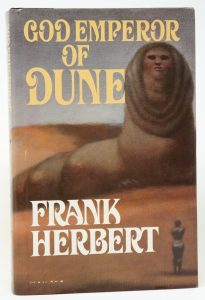“Dune ” is a highly-regarded and beloved science fiction property. It spans six original novels, two follow-ups written by the author’s son, and a huge array of prequels, tie-ins, and canonical media. It has all the pieces to create an entire film universe (a Duneiverse?). It’s shocking that a studio hasn’t scooped it up and started pumping out big-budget blockbusters.
As we mentioned last week, this latest attempt has all of the tools it needs to succeed. With that said, the history of adapting Dune is littered with strong efforts resulting in failure. Great talent, great ambition, and plenty of money have been poured into adaptations before. So why hasn’t anybody succeeded?
Holy crap the mythology is dense
It takes only sentence fragments to explain the premise of Star Trek. They’re explorers on a spaceship, got it. Likewise, Star Wars explains itself pretty simply with the signature scroll at the beginning of each film. Something something rebellion and death star–got it, we’re on board. Explaining Dune however is much more challenging. You only have to look at David Lynch’s attempt from his 1984 adaptation:
That’s, uh, a minor character mumbling for several minutes about “spice”. If you’re not pretty well versed in Dune lore, it doesn’t do much to clear things up. Even more troubling, the extended cut of Dune attempts an opening text crawl ala Star Wars. It lasts several minutes and attempts to fill the audience in on thousands of years of politics and galactic bureaucracy, all of which is crucially important to the plot.
It doesn’t work.
Consider this major spoiler: Despite his results in the Bene Gesserit Gom Jabbar test, Paul Atreides is eventually revealed to be the Kwisatz Haderach. It’s fair to just toss that into an article because it is gibberish. A central challenge to adapting Dune is finding a way to have that sentence make sense to a wide audience. The David Lynch film just didn’t do that.
The books get very, very weird, which could hurt franchise development
Jason Momoa is one of the big names attached to this new adaption. The character he is signed on to play, Duncan Idaho, is fairly minor in the first novel but emerges as one of the main characters in the later books. Bringing a huge name actor to that role makes it appear a franchise could be possible if the film is well received.
Here’s the thing: the books go off the rails pretty quickly. By book four, the Momoa character has been repeatedly cloned over thousands of years to serve a tyrannical, omniscient human/sandworm hybrid who has enslaved humanity using psychic powers. That’s not a subplot. That is the plot. It’s right there on the cover of the book.
Science fiction fans are often willing to accept some strange plot points in their properties. Syfy, back in its Science Fiction Channel days, handled the second two books as a miniseries. They condensed Dune Messiah and Children of Dune into one story, and it more-or-less worked. The largest knocks against that production are that the lower budget limited how all-in they could go on some of the more demanding special effects. Any Dune production considering a full franchise will at some point have to tackle how deeply strange the later books get.
Art direction is a massive undertaking
Alejandro Jodorowsky tried and failed to get a Dune film off the ground. His crew included some of the most famous actors and artists alive. Names like Salvador Dali, Orson Wells, and H.R. Geiger were slated to create characters and provide artistic direction. Music was going to be composed by Pink Floyd. It was an immense amount of talent dedicated to making the world of Dune feel real.
That movie never even got made. The Lynch version managed some striking visuals but never feels like a cohesive whole (jokes about the Sting character’s “leather bikini” invariably pop up in any discussion of that film). The Syfy miniseries didn’t have the budget to assemble a completely believable world. Even the stellar acting in that adaption can’t compensate for a low-budget staging of a giant space opera.
Simply put, things like sandworms, the horrific and mutated space guild members, Castle Harkonnen, and the eerie, glowing eyes of the freemen are difficult to get the look right. Small errors in design change the awesome and majestic sandworms into middle-school joke sandphalluses. Denis Villeneuve has the budget and the talent to make it work. It’s a question of whether he has a delicate enough hand to make it believable.
There are plenty of reasons to be excited about this latest attempt at the property. It is important, though, to remember that money and talent have been assembled before. The world of Dune is well-positioned to make the leap to the big screen, but it presents some enormous, unique challenges. The reason a great adaptation hasn’t been made yet is that any number of small missteps can sink the whole thing.



